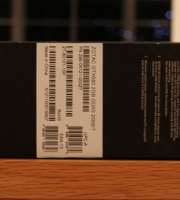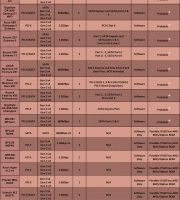

Less Control or Less Secrets?
Three centuries before your eyes met with these ponderously chosen words – humour me with the tenses, it lends the site a certain character – the world of desktop computing was delicately sprawled on a pin…and a tablet and a phone and other, pernicious portable, pretenders to the swivel chair. But many who declared it at death’s door were “types”. Tiresome types. Types with tedious tendencies. Types who, for the preceding decade had purchased their computers in boxes depicting a smiling father filling in a spreadsheet, from places illuminated by noxious neon lights and people wearing mostly nylon whose handshakes were inextricably bound to extended insurance policies.
They meant no harm, but to them the PC was a kettle, or a toaster or a potato. Something to scold when it goes wrong and forsake when it faithfully delivers and the task of keeping one well maintained was as worthy of their attention as the communities of woodlice inside their towers , or the 10.000 viruses brought about by their cursedly stupid clicks on links promising free stuff like a spreadsheet application, even though they had one that worked flawlessly. All of which culminates in their arrogant dismissal of PCs on the pretext of their being slow, unreliable and redundant since acquiring their adorable and resplendent iPad Air, which isn’t working because they forgot to charge it after filling in spreadsheets all night.
In every field there are novices, dabblers and experts and when it comes to debating those less well versed, even if through no fault of their own, the frustrated and abused kick downwards as I just did.
Overclocking video cards was a relatively niche subculture in 2014. Many artisans, proficient at manipulating multipliers, B clocks and FSBs would nonchalantly waive the opportunity to enlist their GPU for a top up. But a recurring opinion divulged by elite practitioners throughout the Maxwell’s impressive reign was that Nvidia had enforced draconian limits on its voltages and frequencies. Forums and tech-sites expounded this argument in such breadth and detail that my head began to spin faster than a Vantec Tornadno. Notwithstanding, I persevered, and via the odd lucid moment compounded with fragments from this site’s shambolic archives, endeavoured to formulate a clearer picture.
Mechanisms to manage thermal and power limits were nothing novel and had been an indigenous part of a CPUs specification long before the video card’s vulnerabilities were even considered. Furthermore, their fundamental characteristics scarcely differed, in spite of what manufacturers claimed, and the confounding illusions scientifically minded journalists conjured up.
Having perused yet further articles, thesis like in scope and scale, many of which dedicated torrents of text to impossibly complicated forms of heat and current regulation, I initially felt the compulsion to learn every word, lest the wisdom should someday complement a bout of convivial philosophical debate, perhaps over a glass of whisky.
Then, mercifully, I realised how much could be curtailed or re-interpreted at no cost to any useful long term knowledge. Yes, I know, pot and kettle. It takes one to know one. The irony is so thick you couldn’t cut it with a claymore and so forth. But at least I acknowledge and ridicule my irony, in itself ironic since that’s how most will defend theirs.
Thus, in an attempt to prove my reckless assertion, I shall proceed with clarity.
Fact. Every single one of these automated algorithms and precautionary processes, no matter how sophisticated their design or operation, was conceived with two things in mind, degrees and watts and how best to make their numbers smaller.
As far as I’m concerned, that was, and is, it. Where elitists actively sought to obfuscate, mulling exhaustively over “target temperatures”, “throttling” “granularity, “algorithms”, “Voltage offsets” and “fan curves”. They merely meant that one, or both of the above was taking place, the making lesser of degrees and watts. They were also were resentful and felt disillusioned, because their traditional, toilsome tampering was becoming of far less relevance to their quest for speed. These “limits” were misconstrued, and merely appeared as such to them because they revealed too many inside secrets and introduced universal procedures for optimization.
The first card ever to have implemented driver level control over its TDP was AMD’s Deep fried Double Decker Cayman, the HD 6990, emerging from its lair in 2011. The Antillies, as it was also known, had a default power limit of 375W. Following a single sacrificial click that allegedly voided your warranty, this value became malleable over a range of 40%, causing the ravenous reptiles to suck upto 450W from the national grid.
Before the Antilies protective measures against temperature and current existed in and a fixed, furtive state, inaccessible via soft tipped tools and unknown to all but those who had waded though 200 pages of certified guidelines and specifications….in print as fine as this. Additionally, the procedure for unlocking a GPU’s adrenal reserves necessitated significant research and an element of risk, but to these experts, it was all part of an enlightening and rewarding adventure.
The fun afforded them by hunting for a hacked BIOS, locating one that appeared to match, tentatively flashing it at the DOS prompt, wondering whether their system would boot. Then when it did, seeing their VCores bolstered and frame-rates enhanced. Everything felt positive and empowering because they had pushed boundaries and given rise to beneficial changes without the aid of a refined software safety net.
After the 6990’s arrival, Nvidia, AMD and a stable of shrewd third parities, were progressively astute in identifying and assuaging an enthusiast’s demands before releasing their wares into the wild. Proprietary applications, previously the privilege of fifty lucky customers and riddled with options to alter settings in the finest increments imaginable was soon the accepted norm.
The performance potential and techniques in attending to it, conquered new heights and catered for the tweaker more generously than ever. Catalysts that hadn’t existed, or were previously an enigma to all without electronics degrees, promptly begged for adjustment. Dozens of utilities with alluring and intuitive graphical interfaces, handed Handy Andy of Average Avenue the ability to conscientiously calibrate voltages, fan velocities and temperatures. One simple point click and drag to raise a card’s TDP, or apply a more aggressive fan profile meant even stock furnished variants could bestow astonishingly high returns.
It sounds immensely exciting but to the experts, the magic had withered away. Extensive and useful functions that in truth, permitted far greater control subconsciously felt restrictive due to their substantial promotion and branding and at pre-launch press events. All was now in plain sight. No matter how liberally they could tinker with Celsius, amps, acoustics and workloads, they were now vividly aware that one omnipresent ordinator would descend like a jack hammer when his patience was pressed.
The consequences of these factory born suppressors varied dramatically from one card to the next, though their duties were as rudimentary as a drone’s conscience:
1: Reduce Energy
2: Reduce Temperature
Sometimes both, but always one, and the only methods in the whole of the known universe to effectively prolong a GPU’s lifespan.